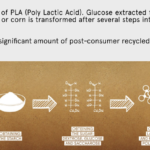What do we leave to our children and grandchildren?
“Humanity has produced more plastic in the last 10 years than the entire 20th century. century in total! We use up the earth’s supply of raw materials, we destroy the forests, we pollute the oceans, while we believe that the earth will be able to regenerate itself. Not able!”
From an environmental protection point of view, plastics – textiles – represent the biggest challenge in the life of our company, as it is difficult to find an environmentally friendly production method from technical fabric.
Fiberglass-PVC textiles are the most common in our industry, for which there is no recycling procedure, but they cannot even be burned. That is, after 20 years spent on the facade, these fabrics can be buried for the future.
(Unfortunately, this is no joke, we know, for example, that the huge fiberglass and synthetic resin composite components of wind power plants are also destroyed in this way, as if burying our heads in the sand. How green is this energy source like this? – editor’s note)
Therefore, our company is constantly looking for a better option, so in recent years we have increasingly used 1005 polyester and polyester-PVC fabrics.
These are not clearly green products either, but at least there is light at the end of the tunnel.
More and more manufacturers have sun nets recycled from PET bottles. Moreover, compostable, plant-based textiles also exist today.
The SeaPlanet FR material is a very high quality fabric produced from PET bottles and fishing nets fished from the sea.
You can read about the textile and the manufacturer here:
https://www.vertisol.com/sustainability/ and https://www.vertisol.com/vertisolfabrics-contract/
The data sheet of the specific textile can be found here.
Pledge Fr is a fabric made from a sugar called PLA synthesized from sugar cane, beet, and corn.
The product pdf can be downloaded by clicking here.
Vertisol screen fabrics, suitable for both indoor and outdoor use, are not only known for their extremely resistant ability, but also for the fact that their heat treatment properties necessary for calculating energy savings are also listed in international software databases such as IDA ESBO, Edibatec or BIM.
A further advance in the use of textiles is that, among the textiles for internal blinds, the market is increasingly willing to pay for fabrics with significantly increased light reflectivity produced by the PEARL process. In this way, the internal shading becomes more efficient, which results in a significant reduction of CO2 emissions, since the building operator has to devote much less energy to cooling.
An example can be downloaded here.
An example of this product can be found on the website of the verotex manufacturer.
https://www.verotex.de/en/products/veroflex-innovative-technology
Fortunately, many projects have been created to clean up the seas, one of them can be read here:
